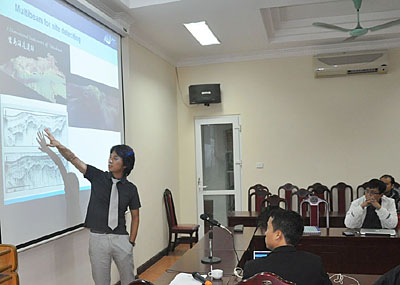
Dr Jun Kimura from the Asia Research Centre at Murdoch University lecturing in the NAS Part 1 course in the Institute of Archaeology lecture theatre on Friday 30 November 2012 (photo by Mark Staniforth).
Introduction
The Nautical Archaeology Society (NAS) training project in Vietnam is designed to increase awareness at local, provincial and national levels about the extent and nature of Vietnam’s underwater and maritime cultural heritage as well as about underwater and maritime archaeology. With the assistance of partners, sponsors and contributors, it is hoped that NAS training can be provided free of charge to Vietnamese students, government agency personnel, archaeologists and others in order to raise awareness about underwater cultural heritage and maritime archaeology in Vietnam, which will help Vietnam to preserve and protect its underwater cultural heritage. At this stage it has only been possible to arrange for the translation of three sessions (sessions 1 to 3) of the Introduction course into Vietnamese but it is hoped that a full and complete translation into Vietnamese will be possible in the future.
If you want to help to expand NAS Training in Vietnam or sponsor the translation of NAS Training into the Vietnamese language then you can donate on our CommonSites website at:
http://projects.commonsites.net/en/project/613/
NAS training in Vietnam forms part of a cooperative five-year agreement (2011-2016) between the Bach Dang River and Van Don Research team and the Institute of Archaeology (IA) in Vietnam. The Nautical Archaeology Society website is available at:
http://www.nauticalarchaeologysociety.org/
UNESCO Convention on the Protection of Underwater Cultural Heritage (2001)
The Underwater Cultural Heritage Training project in Vietnam is based on Article 21 in the UNESCO Convention on the Protection of Underwater Cultural Heritage (2001).
Article 21
States Parties shall cooperate in the provision of training in underwater archaeology, in techniques for the conservation of underwater cultural heritage and, on agreed terms, in the transfer of technology relating to underwater cultural heritage.
Next
